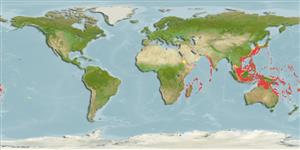Pycnogonida |
Pantopoda |
Phoxichilidiidae
Environment: milieu / climate zone / ระดับความลึก / distribution range
นิเวศวิทยา
เกี่ยวกับหินโสโครก; ระดับความลึก 2 - 235 m (อ้างอิง 1666). Tropical
Indo-West Pacific.
Length at first maturity / ขนาด / Weight / Age
วัยเจริญพันธุ์: Lm ? range ? - ? cm
Subtidal to a depth of 135 m (Ref. 139). Most pycnogonids are carnivores feeding on soft-bodied organisms such as hydroids, soft corals, anemones, bryozoans, small polychaetes and sponges. Some consume algae, microorganisms or detritus (Ref. 833).
Life cycle and mating behavior
วัยเจริญพันธุ์ | การสืบพันธุ์ | การวางไข่ | Eggs | ความดกของไข่ | Larvae
Members of the class Pycnogonida are gonochoric and sexually dimorphic. During copulation, male usually suspends itself beneath the female. Fertilization occurs as the eggs leave the female's ovigers. Males brood the egg masses until they hatch. Life cycle: Eggs hatch into protonymphon larva then to adults.
Arango, C.P. 2002 Morphological phylogenetics of the sea spiders (Arthropoda: Pycnogonida). Organisms Diversity and Evolution 2(2):119-126. (อ้างอิง 1951)
IUCN Red List Status
(อ้างอิง 130435: Version 2025-1)
CITES status (อ้างอิง 108899)
Not Evaluated
CMS (อ้างอิง 116361)
Not Evaluated
Threat to humans
Human uses
| FishSource |
เครื่องมือ
ข้อมูลเพิ่มเติม
นิเวศวิทยาเขตร้อนFood items (preys)
องค์ประอบของอาหาร
การบริโภคอาหาร
ผู้ล่า
Population dynamicsการเจริญเติบโต
Max. ages / sizes
Length-weight rel.
Length-length rel.
Length-frequencies
Mass conversion
อุดมสมบรูณ์
Life cycleการสืบพันธุ์วัยเจริญพันธุ์ความดกของไข่การวางไข่EggsEgg developmentLarvae Human RelatedStamps, coins, misc.
แหล่งที่มาจากอินเตอร์เน็ต
Estimates based on models
Preferred temperature
(Ref.
115969): 17.9 - 28.2, mean 26 (based on 580 cells).
Price category
Unknown.
